No bargain. With the Mate X3, Huawei offers its latest foldable. The concept has been completely revised and the foldable display has now been moved inside as well. In addition, there is a lot of storage, a fast SoC, and a convincing camera setup. However, it is only recommendable for very few due to the known limitations.
Daniel Schmidt, 👁 Daniel Schmidt, ✓ Anton Avdyushkin (translated by DeepL / Ninh Duy), Published 06/24/2023 🇩🇪
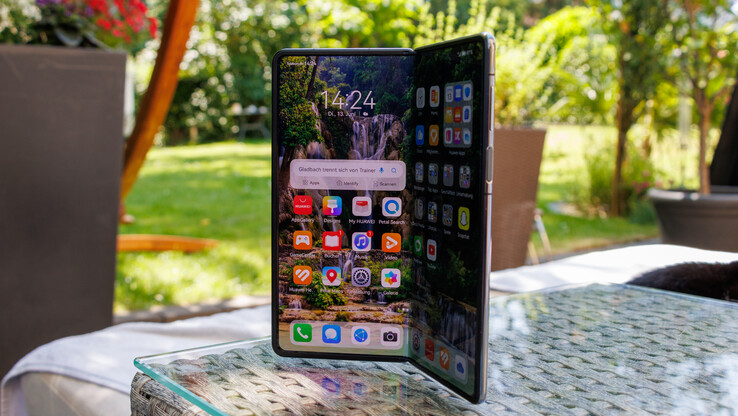
The Mate X3 is the latest foldable smartphone from Huawei, which is the successor of the Mate Xs 2 and for the first time no longer relies on an external panel, but shifts the foldable screen to the inside, as is the case with the competition.
Huawei’s smartphone relies on upscale features, but it is not quite inexpensive at 2,199 Euros (~$4,000). Find out everything about the Mate X3 in the following review.
Display
7.85 inch 10.10:9, 2496 x 2224 pixel 426 PPI, Capacitive, OLED, 1 – 120 Hz LTPO-OLED, 1440 Hz PWM-Dimming; Cover display: 6.4 inches, 2504 x 1080, 1 – 120 Hz LTPO-OLED, 1440 Hz PWM-Dimming, glossy: yes, HDR, 120 Hz
Storage
512 GB UFS 3.1 Flash, 512 GB
, 490.33 GB free
Connections
1 USB 3.0 / 3.1 Gen1, USB-C Power Delivery (PD), 1 HDMI, 1 DisplayPort, 1 Infrared, Audio Connections: USB-C, Card Reader: NanoMemory-Card (up to 256 GB, FAT, FAT32, exFAT), 1 Fingerprint Reader, NFC, Brightness Sensor, Sensors: accelerometer, gyro, proximity, compass, barometer, altimeter, color spectrum, OTG, IR-Blaster
Networking
802.11 a/b/g/n/ac/ax (a/b/g/n=Wi-Fi 4/ac=Wi-Fi 5/ax=Wi-Fi 6/), Bluetooth 5.2, 2G (850, 900, 1800, 1900 MHz), 3G (Band 1, 2, 4, 5, 6, 8, 19), LTE (Band 1, 2, 3, 4, 5, 7, 8, 12, 17, 18, 19, 20, 26, 28, 34, 38, 39, 40, 41), Dual SIM, LTE, GPS
Size
height x width x depth (in mm): 5.3 x 156.9 x 141.5 (=0.21 x 6.18 x 5.57 in)
Battery
4800 mAh Lithium-Polymer
Charging
wireless charging, fast charging / Quickcharge
Operating System
Android 12
Camera
Primary Camera: 50 MPix (f/1.8, 23 mm) + 12 MPix (5x optical zoom, f/3.4, 125 mm) + 13 MPix (Ultrawide, f/2.2, 13 mm); Camera2-API: Full
Secondary Camera: 8 MPix (f/2.4)
Additional features
Speakers: Dual, Keyboard: Onscreen, USB-Cabel, SIM-Tool, transparent case, 66W-Charger, EMUI 13.1, 24 Months Warranty, DRM Widevine L1, GNSS: GPS (L1, L5), Glonass (L1), Galileo (E1, E5a), BeiDou (B1, B1C, B2a), QZSS (L1, L5), NavIC (L5), fanless, waterproof
Weight
239 g (= 8.43 oz / 0.53 pounds) (= 0 oz / 0 pounds)
Note: The manufacturer may use components from different suppliers including display panels, drives or memory sticks with similar specifications.
Rating
Date
Model
Weight
Drive
Size
Resolution
Best Price
86.3 %
06/2023
Huawei Mate X3
SD 8+ Gen 1, Adreno 730239 g512 GB UFS 3.1 Flash7.85″2496×222489.8 %
10/2022
Samsung Galaxy Z Fold4 5G
SD 8+ Gen 1, Adreno 730263 g256 GB UFS 3.1 Flash7.60″2176×181287.2 %
03/2023
Honor Magic Vs
SD 8+ Gen 1, Adreno 730261 g512 GB UFS 3.1 Flash7.90″2272×198486.9 %
08/2022
Vivo X Fold
SD 8 Gen 1, Adreno 730311 g256 GB UFS 3.1 Flash8.03″2160×191686.3 %
12/2022
Xiaomi Mix Fold 2
SD 8+ Gen 1, Adreno 730262 g256 GB UFS 3.1 Flash8.02″2160×1914
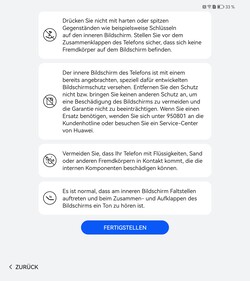 Usage instructions for the Mate X3 are available right at the start.
Usage instructions for the Mate X3 are available right at the start.
The Huawei Mate X3 is available in black and dark green. Unlike all its predecessors, the foldable display is no longer on the outside, but moved to the inside, while an additional panel is integrated on the outside so that the Mate X3 can also be used when folded. It features a very slim design and is also the lightest foldable in the comparison field. Even when folded, it does not look too thick (H x W x D: 156.9 x 72.4 x 11.08 mm). The protruding camera hump pleases us visually and at least when folded, the Mate X3 does not wobble back and forth.
The build quality is convincing. The gaps are tight and very even. Careful twisting attempts do not affect the foldable and do not elicit any creaking. While Kunlun glass is used on the outside, which we already know from the P60 Pro the foldable panel is protected by a protective film that cannot be removed and is made up of several layers. One of them is made of a non-Newtonian, liquid material that is supposed to increase the impact resistance by four times. Huawei displays a corresponding note for handling the smartphone when setting it up (see screenshot).
The hinge has been reworked once again and is not only more durable but can also keep the folding display of the Mate X3 in a stable position continuously within a 130° angle. Furthermore, the phone is waterproof according to IPX8 and thus protected against complete and permanent submersion in fresh water. The Mate X3 is not spared from the typical folds of a foldable, but the edges close flush when folded and no unsightly gaps remain.
Vivo X Fold Huawei Mate Xs 2 Xiaomi Mix Fold 2 Honor Magic Vs Huawei Mate X3 Samsung Galaxy Z Fold4 5G DIN A6 ❌
162 mm / 6.38 inch
142 mm / 5.59 inch
14.6 mm / 0.575 inch
311 g0.686 lbs156.5 mm / 6.16 inch
139.9 mm / 5.51 inch
11.1 mm / 0.437 inch
255 g0.562 lbs161.6 mm / 6.36 inch
144.7 mm / 5.7 inch
5.4 mm / 0.2126 inch
262 g0.578 lbs160.3 mm / 6.31 inch
141.5 mm / 5.57 inch
6.1 mm / 0.2402 inch
261 g0.575 lbs156.9 mm / 6.18 inch
141.5 mm / 5.57 inch
5.3 mm / 0.2087 inch
239 g0.527 lbs155.1 mm / 6.11 inch
130.1 mm / 5.12 inch
6.3 mm / 0.248 inch
263 g0.58 lbs148 mm / 5.83 inch
105 mm / 4.13 inch
1 mm / 0.03937 inch
1.5 g0.00331 lbs
Huawei’s Mate X3 offers 512 GB of internal storage and the additional option to expand it with a NanoMemory Card, which can hold up to 256 GB.
The USB 3.2 (Gen. 1) port supports wired image output, including desktop mode, as well as OTG. The data transfer presents itself as very fast with 391.13 MB/s in the test.
Furthermore, an IR blaster, NFC and Bluetooth 5.2 are also on board.
The Mate X3 cannot use microSD cards, but Huawei’s own NanoMemory cards, which can reach a capacity of up to 256 GB.
The card reader’s speed is really fast and almost completely uses the standard’s possibilities (max. 90 MB/s).
Huawei Mate X3
Adreno 730, SD 8+ Gen 1, 512 GB UFS 3.1 Flash (Huawei NanoMemory)Huawei Mate Xs 2
Adreno 660, SD 888 4G, 512 GB UFS 3.1 Flash (Huawei NanoMemory)Sony Xperia 1 V
Adreno 740, SD 8 Gen 2, 256 GB UFS 4.0 Flash (Angelbird AV Pro V60)
0102030405060708090100110120130140150160170Tooltip
Huawei Mate X3 Adreno 730, SD 8+ Gen 1, 512 GB UFS 3.1 Flash; SDCard Sequential Write 0.5 GB; Huawei NanoMemory: Ø49.7 (22.6-59.2)
Sony Xperia 1 V Adreno 740, SD 8 Gen 2, 256 GB UFS 4.0 Flash; SDCard Sequential Write 0.5 GB; Angelbird AV Pro V60: Ø28.3 (19.6-31.9)
Huawei Mate X3 Adreno 730, SD 8+ Gen 1, 512 GB UFS 3.1 Flash; SDCard Sequential Read 0.5 GB; Huawei NanoMemory: Ø61.2 (8.2-66)
Sony Xperia 1 V Adreno 740, SD 8 Gen 2, 256 GB UFS 4.0 Flash; SDCard Sequential Read 0.5 GB; Angelbird AV Pro V60: Ø45.7 (28.7-176.3)
The Huawei Mate X3 ships with EMUI 13.1 in Europe, which is based on Android 12. Harmony OS 3.1 is used in the Asian markets, which does not differ in terms of looks and structure. Huawei does not provide detailed information about the update supply, but it has always been good in the past. The security patches were updated on April 1, 2023 at the time of the test and are thus no longer up-to-date.
As in the past years, the Mate X3 still has to do without Google services and the corresponding apps. Huawei’s own AppGallery contains many well-known apps, but major American providers like Meta, Netflix, and Disney are missing. Many of these apps can be downloaded and installed via other platforms using the Petal search, but this is anything but easy, especially for less tech-savvy users. A better alternative can be the GBox, which is easy to install and provides the Play Store and most Google services. However, this can lead to increased battery consumption, and it is not harmless in terms of data protection.
Like its predecessor, Huawei is not allowed to integrate 5G mobile in the Mate X3. Accordingly, LTE is available at best, but it has a broad frequency coverage.
Huawei’s smartphone achieves fast and stable transmission rates in combination with our reference router Asus ROG Rapture GT-AXE11000. However, it does not support Wi-Fi 6E or Wi-Fi 7 and thus no 6 GHz WLAN. Huawei promises the use of VHT160, which should allow data rates beyond 1 GBit/s in the 5 GHz network without problems. However, the Mate X3 did not achieve these in the test.
iperf3 receive AXE11000
928 (min: 851) MBit/s ∼71%
iperf3 transmit AXE11000
934 (min: 888) MBit/s ∼64%
iperf3 receive AXE11000
882 (min: 836) MBit/s ∼67%
iperf3 transmit AXE11000
913 (min: 455) MBit/s ∼62%
iperf3 receive AXE11000
1315 (min: 1162) MBit/s ∼100%
iperf3 transmit AXE11000
1467 (min: 1101) MBit/s ∼100%
iperf3 receive AXE11000
923 (min: 715) MBit/s ∼70%
iperf3 transmit AXE11000
887 (min: 845) MBit/s ∼60%
iperf3 receive AXE11000
808 (min: 737) MBit/s ∼61%
iperf3 transmit AXE11000
915 (min: 858) MBit/s ∼62%
iperf3 receive AXE11000
653 (min: 585) MBit/s ∼50%
iperf3 transmit AXE11000
844 (min: 415) MBit/s ∼58%
iperf3 receive AXE11000
627 (min: 34.8) MBit/s ∼48%
iperf3 transmit AXE11000
663 (min: 40.5) MBit/s ∼45%
050100150200250300350400450500550600650700750800850900950Tooltip
Huawei Mate X3 Qualcomm Snapdragon 8+ Gen 1, Qualcomm Adreno 730; iperf3 receive AXE11000; iperf 3.1.3: Ø927 (851-952)
Samsung Galaxy Z Fold4 5G Qualcomm Snapdragon 8+ Gen 1, Qualcomm Adreno 730; iperf3 receive AXE11000; iperf 3.1.3: Ø881 (836-927)
Huawei Mate X3 Qualcomm Snapdragon 8+ Gen 1, Qualcomm Adreno 730; iperf3 transmit AXE11000; iperf 3.1.3: Ø934 (888-965)
Samsung Galaxy Z Fold4 5G Qualcomm Snapdragon 8+ Gen 1, Qualcomm Adreno 730; iperf3 transmit AXE11000; iperf 3.1.3: Ø898 (455-948)
With broad GNSS support and an integrated barometer, the Huawei Mate X3 has the best prerequisites to guide its owner safely through unknown terrain. The Satfix is very fast and accurate even indoors.
During a short bike ride, the foldable has to face comparison with the Garmin Venu 2. The recorded route of around 10 kilometers is 90 meters shorter on the X3, but the altitude meters are almost identical. A look at the detailed route shows that Huawei’s smartphone records the route well, but it is sometimes a bit off track.
Huawei’s Mate X3 supports features like VoLTE and WLAN calls, but SIP account control is not implemented into the system. It can take up to two nano-SIM cards as long as one slot is not occupied by an optional memory card. The Foldable does not have an eSIM.
The voice quality is very good when held to the ear and even louder ambient noise is reliably filtered out. The speaker is also decent but reverberates a bit.
Each display of the Mate X3 has its own 8 MPix camera, both of which have an f/2.4 aperture and allow decent selfies. Videos can be recorded in Ultra HD at best, but the optics on the small display are limited to 30 FPS, while the one on the foldable panel is also capable of 60 FPS despite the identical resolution.
If you like, you can also use the main camera setup as the front camera. All you have to do is press a button in the app and the additional display then serves as a viewfinder. But especially for conventional photography, the Huawei Mate X3 can fully show its strengths and takes good pictures in daylight. Low-light pictures also turn out well, but they are a bit too reddish. The ultra wide-angle lens could have emphasized contours a bit more and the lens curvature becomes quite visible towards the edge, but it does a good job otherwise and is also responsible for macro subjects. The periscope optics allow a five-fold optical magnification, including optical image stabilization (OIS), which no other foldable smartphone offers. Digitally, even a 50x magnification is possible.
Videos can be recorded in Ultra HD with 30 or 60 FPS.
Image Comparison
Choose a scene and navigate within the first image. One click changes the position on touchscreens. One click on the zoomed-in image opens the original in a new window. The first image shows the scaled photograph of the test device.
Main cameraMain cameraUltra wide-angle5x ZoomLow-Light

click to load images
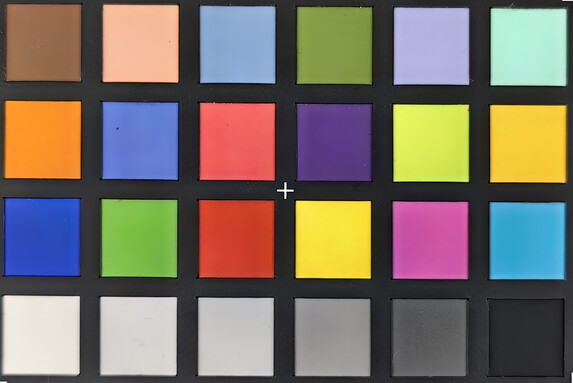
11.5 ∆E
11.8 ∆E
16 ∆E
19.9 ∆E
15.7 ∆E
13.7 ∆E
8.7 ∆E
13.3 ∆E
10.4 ∆E
7 ∆E
12.6 ∆E
12.8 ∆E
6.6 ∆E
14.7 ∆E
10.6 ∆E
6.8 ∆E
4.1 ∆E
13.3 ∆E
5.9 ∆E
3.3 ∆E
10.5 ∆E
10.2 ∆E
2 ∆E
3.6 ∆E
ColorChecker Huawei Mate X3: 10.21 ∆E min: 1.95 – max: 19.86 ∆E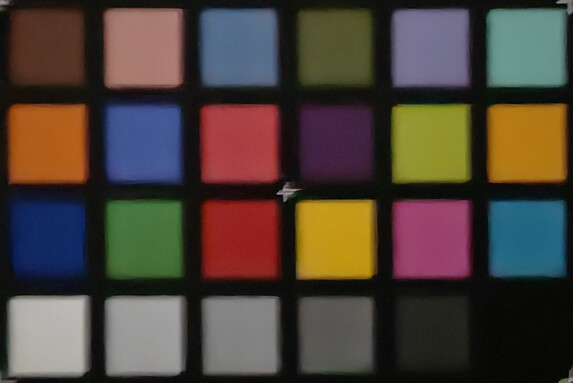
10.4 ∆E
9.7 ∆E
6.1 ∆E
9.9 ∆E
7.8 ∆E
12.4 ∆E
11.8 ∆E
3.6 ∆E
8.4 ∆E
10.1 ∆E
11.9 ∆E
13.8 ∆E
9.8 ∆E
11.9 ∆E
7.2 ∆E
13.5 ∆E
10.6 ∆E
11 ∆E
15.5 ∆E
12.8 ∆E
10.6 ∆E
13.1 ∆E
17.2 ∆E
12.8 ∆E
ColorChecker Huawei Mate X3: 10.9 ∆E min: 3.57 – max: 17.16 ∆E
The Huawei Mate X3 has a 24-month warranty in Germany. It comes with a clear protective case that clips onto the back with the camera. A modular 66-Watt power supply is also included, as well as a matching USB cable (Type-A to Type-C), an additional protective film for the cover display, and a SIM tool.
Both capacitive touchscreens of the Huawei Mate X3 work very reliably in the test. However, the surface of the cover display is noticeably more slippery and offers less resistance to the fingers. Like the Galaxy Z Fold4, Huawei’s foldable also supports active pen input for the main display, but the necessary Huawei M-Pen 2s is currently only available in Asia. However, it can be imported via AliExpress (148 euro).
A fingerprint sensor in the power button is available for biometric security. It has very good recognition rates and unlocks the X3 quickly. Face recognition can be used additionally or alternatively, but it is less secure.
The X3 is again capable of finger-touch input, supports numerous gestures and even has a senior mode on board, which can be used to adjust the display size and control the touchscreen’s typing time, among other things.
The main display of the Huawei Mate X3 is now on the inside and grows minimally to 7.85 inches. It supports the HDR standards HLG, HDR10, and HDR10+. The refresh rate of the LTPO OLED panel reaches up to 120 Hz, the system dynamically adjusts this between 1 and 120 Hz, alternatively, it is possible to fix the refresh rate to 60 or 120 Hz.
The brightness has been improved compared to the Mate Xs 2 and now reaches an average of 969 cd/m2 when the ambient light sensor is active. This value remains on the same level even with an even distribution of bright and dark areas (APL18), and the brightness is not increased further even in HDR rendering. Those who prefer to adjust the brightness manually have 476 cd/m2 at their disposal.
The smaller cover display on the outside also relies on OLED technology, but it can get even brighter. While the brightness is almost identical in manual mode (max. 479 cd/m2), the smaller panel can increase a bit in the APL18 test and reaches up to 1,239 cd/m2.
OLED flickering is very similar in both displays. We measured a fairly constant 90 Hz depending on the zoom level, which could be a burn-in protection or black frame insertion. Zooming in closer, we can measure a frequency between 425 and 549 Hz at minimum display brightness. The Mate X3 uses PWM dimming with 1,440 Hz for both displays, which is considered comparatively easy on the eyes.
978
cd/m²948
cd/m²946
cd/m²997
cd/m²948
cd/m²966
cd/m²1010
cd/m²957
cd/m²974
cd/m²
Distribution of brightness
Foldable Display (X-Rite i1Pro 3)
Maximum: 1010 cd/m² (Nits) Average: 969.3 cd/m² Minimum: 2.24 cd/m²
Brightness Distribution: 94 %
Center on Battery: 948 cd/m²
Contrast: ∞:1 (Black: 0 cd/m²)
ΔE Color 1.4 | 0.55-29.43 Ø5.1
ΔE Greyscale 1.7 | 0.57-98 Ø5.4
99.3% sRGB (Calman 2D)
Gamma: 2.15
1161
cd/m²1163
cd/m²1140
cd/m²1169
cd/m²1160
cd/m²1163
cd/m²1164
cd/m²1163
cd/m²1196
cd/m²
Distribution of brightness
Cover Display (X-Rite i1Pro 3)
Maximum: 1196 cd/m² (Nits) Average: 1164.3 cd/m² Minimum: 1.99 cd/m²
Brightness Distribution: 95 %
Center on Battery: 1160 cd/m²
Contrast: ∞:1 (Black: 0 cd/m²)
ΔE Color 1.4 | 0.55-29.43 Ø5.1
ΔE Greyscale 2.4 | 0.57-98 Ø5.4
99.4% sRGB (Calman 2D)
Gamma: 2.16
Huawei Mate X3
OLED, 2496×2224, 7.85Samsung Galaxy Z Fold4 5G
Dynamic AMOLED, 2176×1812, 7.60Honor Magic Vs
OLED, 2272×1984, 7.90Vivo X Fold
AMOLED, 2160×1916, 8.03Xiaomi Mix Fold 2
OLED, 2160×1914, 8.02Huawei Mate Xs 2
OLED, 2480×2220, 7.80Brightness middle
948
913
-4%
803
-15%
730
-23%
1015
7%
763
-20%
Brightness
969
929
-4%
809
-17%
724
-25%
1022
5%
769
-21%
Brightness Distribution
94
96
2%
97
3%
95
1%
98
4%
95
1%
Black Level *Colorchecker dE 2000 *
1.4
1.7
-21%
2.27
-62%
1.66
-19%
1.6
-14%
2.8
-100%
Colorchecker dE 2000 max. *
2.6
3.6
-38%
5.99
-130%
2.92
-12%
3.4
-31%
5.9
-127%
Greyscale dE 2000 *
1.7
1.5
12%
3.9
-129%
1.6
6%
2.6
-53%
4.3
-153%
Gamma
2.15 102%
2.16 102%
2.25 98%
2.28 96%
2.22 99%
2.24 98%
CCT
6539 99%
6515 100%
6234 104%
6395 102%
6506 100%
6457 101%
* … smaller is better
Screen Flickering / PWM (Pulse-Width Modulation)
ℹ
To dim the screen, some notebooks will simply cycle the backlight on and off in rapid succession – a method called Pulse Width Modulation (PWM) . This cycling frequency should ideally be undetectable to the human eye. If said frequency is too low, users with sensitive eyes may experience strain or headaches or even notice the flickering altogether.
Screen flickering / PWM detected 484 Hz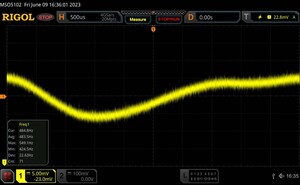
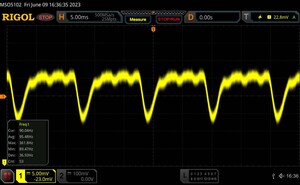
The display backlight flickers at 484 Hz (Likely utilizing PWM) .
The frequency of 484 Hz is relatively high, so most users sensitive to PWM should not notice any flickering. However, there are reports that some users are still sensitive to PWM at 500 Hz and above, so be aware.
In comparison: 53 % of all tested devices do not use PWM to dim the display. If PWM was detected, an average of 19025 (minimum: 5 – maximum: 3846000) Hz was measured.
Measurement series with fixed zoom level and different brightness settings
The analysis with Calman shows that the two displays of the Huawei Mate X3 are both well-calibrated and matched.
Display Response Times
ℹ
Display response times show how fast the screen is able to change from one color to the next. Slow response times can lead to afterimages and can cause moving objects to appear blurry (ghosting). Gamers of fast-paced 3D titles should pay special attention to fast response times.
Outdoors, the Mate X3 remains easy to read even in sunlight and the ambient light sensors always adjust the brightness quickly.
The viewing angle stability of the foldable display remains a bit better in terms of color representation because the cover display shows a slightly warmer picture at flat viewing angles. However, this does not bother in everyday use.
The Huawei Mate X3 is powered by a Snapdragon 8+ Gen 1 in the 4G version and has access to a generous 12 GB of LPDDR5 working memory. Thus, the SoC is not cutting-edge, but it is still very fast and also used by many rivals.
The benchmarks are within the expected range and certify the Huawei smartphone’s high performance. Even though a performance mode is available again, we did not use it. The differences are not too big, but the option is particularly noticeable in terms of heat development.
Samsung Galaxy Z Fold4 5G
Qualcomm Snapdragon 8+ Gen 1, Adreno 730, 12288
1334 Points ∼100% +3%
Xiaomi Mix Fold 2
Qualcomm Snapdragon 8+ Gen 1, Adreno 730, 12288
1324 Points ∼99% +2%
Huawei Mate X3
Qualcomm Snapdragon 8+ Gen 1, Adreno 730, 12288
1292 Points ∼97%
Average Qualcomm Snapdragon 8+ Gen 1
(897 – 1356, n=20)
1276 Points ∼96% -1%
Vivo X Fold
Qualcomm Snapdragon 8 Gen 1, Adreno 730, 12288
1232 Points ∼92% -5%
Huawei Mate Xs 2
Qualcomm Snapdragon 888 4G, Adreno 660, 8192
1107 Points ∼83% -14%
Honor Magic Vs
Qualcomm Snapdragon 8+ Gen 1, Adreno 730, 12288
897 Points ∼67% -31%
Average of class Smartphone
(119 – 1885, n=238, last 2 years)
827 Points ∼62% -36%
Huawei Mate X3
Qualcomm Snapdragon 8+ Gen 1, Adreno 730, 12288
4320 Points ∼100%
Xiaomi Mix Fold 2
Qualcomm Snapdragon 8+ Gen 1, Adreno 730, 12288
4237 Points ∼98% -2%
Average Qualcomm Snapdragon 8+ Gen 1
(3782 – 4436, n=20)
4180 Points ∼97% -3%
Samsung Galaxy Z Fold4 5G
Qualcomm Snapdragon 8+ Gen 1, Adreno 730, 12288
4065 Points ∼94% -6%
Honor Magic Vs
Qualcomm Snapdragon 8+ Gen 1, Adreno 730, 12288
3782 Points ∼88% -12%
Vivo X Fold
Qualcomm Snapdragon 8 Gen 1, Adreno 730, 12288
3600 Points ∼83% -17%
Huawei Mate Xs 2
Qualcomm Snapdragon 888 4G, Adreno 660, 8192
3334 Points ∼77% -23%
Average of class Smartphone
(473 – 5538, n=238, last 2 years)
2651 Points ∼61% -39%
Xiaomi Mix Fold 2
Qualcomm Snapdragon 8+ Gen 1, Adreno 730, 12288
1057225 Points ∼100% +7%
Average Qualcomm Snapdragon 8+ Gen 1
(782013 – 1119358, n=18)
997983 Points ∼94% +1%
Huawei Mate X3
Qualcomm Snapdragon 8+ Gen 1, Adreno 730, 12288
985150 Points ∼93%
Samsung Galaxy Z Fold4 5G
Qualcomm Snapdragon 8+ Gen 1, Adreno 730, 12288
973843 Points ∼92% -1%
Honor Magic Vs
Qualcomm Snapdragon 8+ Gen 1, Adreno 730, 12288
782013 Points ∼74% -21%
Average of class Smartphone
(111952 – 1322448, n=164, last 2 years)
660692 Points ∼62% -33%
Average Qualcomm Snapdragon 8+ Gen 1
(11029 – 17727, n=19)
14555 Points ∼100% +15%
Samsung Galaxy Z Fold4 5G
Qualcomm Snapdragon 8+ Gen 1, Adreno 730, 12288
13983 Points ∼96% +11%
Xiaomi Mix Fold 2
Qualcomm Snapdragon 8+ Gen 1, Adreno 730, 12288
13195 Points ∼91% +5%
Huawei Mate X3
Qualcomm Snapdragon 8+ Gen 1, Adreno 730, 12288
12606 Points ∼87%
Vivo X Fold
Qualcomm Snapdragon 8 Gen 1, Adreno 730, 12288
12100 Points ∼83% -4%
Honor Magic Vs
Qualcomm Snapdragon 8+ Gen 1, Adreno 730, 12288
11296 Points ∼78% -10%
Huawei Mate Xs 2
Qualcomm Snapdragon 888 4G, Adreno 660, 8192
11230 Points ∼77% -11%
Average of class Smartphone
(4780 – 28378, n=226, last 2 years)
10703 Points ∼74% -15%
Samsung Galaxy Z Fold4 5G
Qualcomm Snapdragon 8+ Gen 1, Adreno 730, 12288
1178 Points ∼100% +5%
Huawei Mate X3
Qualcomm Snapdragon 8+ Gen 1, Adreno 730, 12288
1117 Points ∼95%
Average Qualcomm Snapdragon 8+ Gen 1
(749 – 1178, n=18)
1024 Points ∼87% -8%
Xiaomi Mix Fold 2
Qualcomm Snapdragon 8+ Gen 1, Adreno 730, 12288
975 Points ∼83% -13%
Honor Magic Vs
Qualcomm Snapdragon 8+ Gen 1, Adreno 730, 12288
911 Points ∼77% -18%
Average of class Smartphone
(226 – 1356, n=135, last 2 years)
795 Points ∼67% -29%
Samsung Galaxy Z Fold4 5G
Qualcomm Snapdragon 8+ Gen 1, Adreno 730, 12288
7858 Points ∼100% +9%
Average Qualcomm Snapdragon 8+ Gen 1
(5642 – 8753, n=18)
7496 Points ∼95% +4%
Huawei Mate X3
Qualcomm Snapdragon 8+ Gen 1, Adreno 730, 12288
7236 Points ∼92%
Xiaomi Mix Fold 2
Qualcomm Snapdragon 8+ Gen 1, Adreno 730, 12288
7003 Points ∼89% -3%
Huawei Mate Xs 2
Qualcomm Snapdragon 888 4G, Adreno 660, 8192
5722 Points ∼73% -21%
Honor Magic Vs
Qualcomm Snapdragon 8+ Gen 1, Adreno 730, 12288
5642 Points ∼72% -22%
Average of class Smartphone
(411 – 9585, n=164, last 2 years)
5137 Points ∼65% -29%
Samsung Galaxy Z Fold4 5G
Qualcomm Snapdragon 8+ Gen 1, Adreno 730, 12288
12839 Points ∼100% +4%
Huawei Mate X3
Qualcomm Snapdragon 8+ Gen 1, Adreno 730, 12288
12326 Points ∼96%
Average Qualcomm Snapdragon 8+ Gen 1
(8750 – 13563, n=18)
11818 Points ∼92% -4%
Xiaomi Mix Fold 2
Qualcomm Snapdragon 8+ Gen 1, Adreno 730, 12288
11275 Points ∼88% -9%
Huawei Mate Xs 2
Qualcomm Snapdragon 888 4G, Adreno 660, 8192
10078 Points ∼78% -18%
Average of class Smartphone
(2565 – 19657, n=164, last 2 years)
8894 Points ∼69% -28%
Honor Magic Vs
Qualcomm Snapdragon 8+ Gen 1, Adreno 730, 12288
8750 Points ∼68% -29%
Huawei Mate X3
Qualcomm Snapdragon 8+ Gen 1, Adreno 730, 12288
8846 Points ∼100%
Samsung Galaxy Z Fold4 5G
Qualcomm Snapdragon 8+ Gen 1, Adreno 730, 12288
7782 Points ∼88% -12%
Average Qualcomm Snapdragon 8+ Gen 1
(3871 – 9114, n=18)
7472 Points ∼84% -16%
Xiaomi Mix Fold 2
Qualcomm Snapdragon 8+ Gen 1, Adreno 730, 12288
7342 Points ∼83% -17%
Huawei Mate Xs 2
Qualcomm Snapdragon 888 4G, Adreno 660, 8192
7081 Points ∼80% -20%
Average of class Smartphone
(670 – 11617, n=164, last 2 years)
5636 Points ∼64% -36%
Honor Magic Vs
Qualcomm Snapdragon 8+ Gen 1, Adreno 730, 12288
3871 Points ∼44% -56%
Honor Magic Vs
Qualcomm Snapdragon 8+ Gen 1, Adreno 730, 12288
23174 Points ∼100% +10%
Average Qualcomm Snapdragon 8+ Gen 1
(16742 – 26660, n=18)
21521 Points ∼93% +3%
Huawei Mate X3
Qualcomm Snapdragon 8+ Gen 1, Adreno 730, 12288
20974 Points ∼91%
Samsung Galaxy Z Fold4 5G
Qualcomm Snapdragon 8+ Gen 1, Adreno 730, 12288
19283 Points ∼83% -8%
Xiaomi Mix Fold 2
Qualcomm Snapdragon 8+ Gen 1, Adreno 730, 12288
18021 Points ∼78% -14%
Huawei Mate Xs 2
Qualcomm Snapdragon 888 4G, Adreno 660, 8192
15539 Points ∼67% -26%
Average of class Smartphone
(697 – 30125, n=164, last 2 years)
11228 Points ∼48% -46%
Samsung Galaxy Z Fold4 5G
Qualcomm Snapdragon 8+ Gen 1, Adreno 730, 12288
1982 Points ∼100% +65%
Average Qualcomm Snapdragon 8+ Gen 1
(1198 – 2006, n=18)
1709 Points ∼86% +43%
Xiaomi Mix Fold 2
Qualcomm Snapdragon 8+ Gen 1, Adreno 730, 12288
1612 Points ∼81% +35%
Average of class Smartphone
(10 – 2392, n=164, last 2 years)
1446 Points ∼73% +21%
Honor Magic Vs
Qualcomm Snapdragon 8+ Gen 1, Adreno 730, 12288
1291 Points ∼65% +8%
Huawei Mate X3
Qualcomm Snapdragon 8+ Gen 1, Adreno 730, 12288
1198 Points ∼60%
Huawei Mate Xs 2
Qualcomm Snapdragon 888 4G, Adreno 660, 8192
967 Points ∼49% -19%
The graphics calculations are handled by the integrated Adreno 730 which was the fastest GPU for Android smartphones in 2022. The Mate X3 delivers a convincing performance in the benchmarks and can often place itself at the top of the comparison field. Thus, there is more than enough performance for games and other graphics-intensive apps.
Samsung Galaxy Z Fold4 5G
Adreno 730, SD 8+ Gen 1, 256 GB UFS 3.1 Flash
2766 Points ∼100% 0%
Huawei Mate X3
Adreno 730, SD 8+ Gen 1, 512 GB UFS 3.1 Flash
2757 Points ∼100%
Honor Magic Vs
Adreno 730, SD 8+ Gen 1, 512 GB UFS 3.1 Flash
2735 Points ∼99% -1%
Xiaomi Mix Fold 2
Adreno 730, SD 8+ Gen 1, 256 GB UFS 3.1 Flash
2726 Points ∼99% -1%
Vivo X Fold
Adreno 730, SD 8 Gen 1, 256 GB UFS 3.1 Flash
2496 Points ∼90% -9%
Huawei Mate Xs 2
Adreno 660, SD 888 4G, 512 GB UFS 3.1 Flash
1449 Points ∼52% -47%
Huawei Mate X3
Adreno 730, SD 8+ Gen 1, 512 GB UFS 3.1 Flash
2821 Points ∼100%
Honor Magic Vs
Adreno 730, SD 8+ Gen 1, 512 GB UFS 3.1 Flash
2799 Points ∼99% -1%
Xiaomi Mix Fold 2
Adreno 730, SD 8+ Gen 1, 256 GB UFS 3.1 Flash
2795 Points ∼99% -1%
Samsung Galaxy Z Fold4 5G
Adreno 730, SD 8+ Gen 1, 256 GB UFS 3.1 Flash
2778 Points ∼98% -2%
Vivo X Fold
Adreno 730, SD 8 Gen 1, 256 GB UFS 3.1 Flash
2585 Points ∼92% -8%
Huawei Mate Xs 2
Adreno 660, SD 888 4G, 512 GB UFS 3.1 Flash
1494 Points ∼53% -47%
Samsung Galaxy Z Fold4 5G
Adreno 730, SD 8+ Gen 1, 256 GB UFS 3.1 Flash
11098 Points ∼100% +1%
Huawei Mate X3
Adreno 730, SD 8+ Gen 1, 512 GB UFS 3.1 Flash
11041 Points ∼99%
Xiaomi Mix Fold 2
Adreno 730, SD 8+ Gen 1, 256 GB UFS 3.1 Flash
11022 Points ∼99% 0%
Honor Magic Vs
Adreno 730, SD 8+ Gen 1, 512 GB UFS 3.1 Flash
10893 Points ∼98% -1%
Huawei Mate Xs 2
Adreno 660, SD 888 4G, 512 GB UFS 3.1 Flash
5666 Points ∼51% -49%
Honor Magic Vs
Adreno 730, SD 8+ Gen 1, 512 GB UFS 3.1 FlashHuawei Mate Xs 2
Adreno 660, SD 888 4G, 512 GB UFS 3.1 FlashSamsung Galaxy Z Fold4 5G
Adreno 730, SD 8+ Gen 1, 256 GB UFS 3.1 Flash
120 fps ∼100% +35%
Xiaomi Mix Fold 2
Adreno 730, SD 8+ Gen 1, 256 GB UFS 3.1 Flash
119 fps ∼99% +34%
Huawei Mate X3
Adreno 730, SD 8+ Gen 1, 512 GB UFS 3.1 Flash
89 fps ∼74%
Huawei Mate Xs 2
Adreno 660, SD 888 4G, 512 GB UFS 3.1 Flash
60 fps ∼50% -33%
Honor Magic Vs
Adreno 730, SD 8+ Gen 1, 512 GB UFS 3.1 Flash
60 fps ∼50% -33%
Huawei Mate X3
Adreno 730, SD 8+ Gen 1, 512 GB UFS 3.1 Flash
434 fps ∼100%
Honor Magic Vs
Adreno 730, SD 8+ Gen 1, 512 GB UFS 3.1 Flash
419 fps ∼97% -3%
Xiaomi Mix Fold 2
Adreno 730, SD 8+ Gen 1, 256 GB UFS 3.1 Flash
381 fps ∼88% -12%
Samsung Galaxy Z Fold4 5G
Adreno 730, SD 8+ Gen 1, 256 GB UFS 3.1 Flash
298 fps ∼69% -31%
Huawei Mate Xs 2
Adreno 660, SD 888 4G, 512 GB UFS 3.1 Flash
262 fps ∼60% -40%
Samsung Galaxy Z Fold4 5G
Adreno 730, SD 8+ Gen 1, 256 GB UFS 3.1 Flash
118 fps ∼100% +33%
Xiaomi Mix Fold 2
Adreno 730, SD 8+ Gen 1, 256 GB UFS 3.1 Flash
111 fps ∼94% +25%
Huawei Mate X3
Adreno 730, SD 8+ Gen 1, 512 GB UFS 3.1 Flash
89 fps ∼75%
Honor Magic Vs
Adreno 730, SD 8+ Gen 1, 512 GB UFS 3.1 Flash
60 fps ∼51% -33%
Huawei Mate Xs 2
Adreno 660, SD 888 4G, 512 GB UFS 3.1 Flash
49 fps ∼42% -45%
Honor Magic Vs
Adreno 730, SD 8+ Gen 1, 512 GB UFS 3.1 Flash
238 fps ∼100% +7%
Huawei Mate X3
Adreno 730, SD 8+ Gen 1, 512 GB UFS 3.1 Flash
222 fps ∼93%
Xiaomi Mix Fold 2
Adreno 730, SD 8+ Gen 1, 256 GB UFS 3.1 Flash
211 fps ∼89% -5%
Samsung Galaxy Z Fold4 5G
Adreno 730, SD 8+ Gen 1, 256 GB UFS 3.1 Flash
179 fps ∼75% -19%
Huawei Mate Xs 2
Adreno 660, SD 888 4G, 512 GB UFS 3.1 Flash
73 fps ∼31% -67%
Samsung Galaxy Z Fold4 5G
Adreno 730, SD 8+ Gen 1, 256 GB UFS 3.1 Flash
79 fps ∼100% +13%
Xiaomi Mix Fold 2
Adreno 730, SD 8+ Gen 1, 256 GB UFS 3.1 Flash
74 fps ∼94% +6%
Huawei Mate X3
Adreno 730, SD 8+ Gen 1, 512 GB UFS 3.1 Flash
70 fps ∼89%
Honor Magic Vs
Adreno 730, SD 8+ Gen 1, 512 GB UFS 3.1 Flash
60 fps ∼76% -14%
Huawei Mate Xs 2
Adreno 660, SD 888 4G, 512 GB UFS 3.1 Flash
19 fps ∼24% -73%
Honor Magic Vs
Adreno 730, SD 8+ Gen 1, 512 GB UFS 3.1 Flash
146 fps ∼100% +12%
Xiaomi Mix Fold 2
Adreno 730, SD 8+ Gen 1, 256 GB UFS 3.1 Flash
145 fps ∼99% +12%
Huawei Mate X3
Adreno 730, SD 8+ Gen 1, 512 GB UFS 3.1 Flash
130 fps ∼89%
Samsung Galaxy Z Fold4 5G
Adreno 730, SD 8+ Gen 1, 256 GB UFS 3.1 Flash
115 fps ∼79% -12%
Huawei Mate Xs 2
Adreno 660, SD 888 4G, 512 GB UFS 3.1 Flash
76 fps ∼52% -42%
Samsung Galaxy Z Fold4 5G
Adreno 730, SD 8+ Gen 1, 256 GB UFS 3.1 Flash
76 fps ∼100% +85%
Honor Magic Vs
Adreno 730, SD 8+ Gen 1, 512 GB UFS 3.1 Flash
55 fps ∼72% +34%
Xiaomi Mix Fold 2
Adreno 730, SD 8+ Gen 1, 256 GB UFS 3.1 Flash
43 fps ∼57% +5%
Huawei Mate X3
Adreno 730, SD 8+ Gen 1, 512 GB UFS 3.1 Flash
41 fps ∼54%
Huawei Mate Xs 2
Adreno 660, SD 888 4G, 512 GB UFS 3.1 Flash
17 fps ∼22% -59%
Huawei Mate X3
Adreno 730, SD 8+ Gen 1, 512 GB UFS 3.1 Flash
103 fps ∼100%
Honor Magic Vs
Adreno 730, SD 8+ Gen 1, 512 GB UFS 3.1 Flash
94 fps ∼91% -9%
Xiaomi Mix Fold 2
Adreno 730, SD 8+ Gen 1, 256 GB UFS 3.1 Flash
83 fps ∼81% -19%
Samsung Galaxy Z Fold4 5G
Adreno 730, SD 8+ Gen 1, 256 GB UFS 3.1 Flash
77 fps ∼75% -25%
Huawei Mate Xs 2
Adreno 660, SD 888 4G, 512 GB UFS 3.1 Flash
63 fps ∼61% -39%
Samsung Galaxy Z Fold4 5G
Adreno 730, SD 8+ Gen 1, 256 GB UFS 3.1 Flash
78 fps ∼100% +152%
Honor Magic Vs
Adreno 730, SD 8+ Gen 1, 512 GB UFS 3.1 Flash
45 fps ∼58% +45%
Vivo X Fold
Adreno 730, SD 8 Gen 1, 256 GB UFS 3.1 Flash
39 fps ∼50% +26%
Xiaomi Mix Fold 2
Adreno 730, SD 8+ Gen 1, 256 GB UFS 3.1 Flash
32 fps ∼41% +3%
Huawei Mate X3
Adreno 730, SD 8+ Gen 1, 512 GB UFS 3.1 Flash
31 fps ∼40%
Huawei Mate Xs 2
Adreno 660, SD 888 4G, 512 GB UFS 3.1 Flash
20 fps ∼26% -35%
Huawei Mate X3
Adreno 730, SD 8+ Gen 1, 512 GB UFS 3.1 Flash
50 fps ∼100%
Honor Magic Vs
Adreno 730, SD 8+ Gen 1, 512 GB UFS 3.1 Flash
41 fps ∼82% -18%
Samsung Galaxy Z Fold4 5G
Adreno 730, SD 8+ Gen 1, 256 GB UFS 3.1 Flash
40 fps ∼80% -20%
Vivo X Fold
Adreno 730, SD 8 Gen 1, 256 GB UFS 3.1 Flash
39 fps ∼78% -22%
Xiaomi Mix Fold 2
Adreno 730, SD 8+ Gen 1, 256 GB UFS 3.1 Flash
39 fps ∼78% -22%
Huawei Mate Xs 2
Adreno 660, SD 888 4G, 512 GB UFS 3.1 Flash
27 fps ∼54% -46%
Samsung Galaxy Z Fold4 5G
Adreno 730, SD 8+ Gen 1, 256 GB UFS 3.1 Flash
97 fps ∼100% +90%
Honor Magic Vs
Adreno 730, SD 8+ Gen 1, 512 GB UFS 3.1 Flash
59 fps ∼61% +16%
Vivo X Fold
Adreno 730, SD 8 Gen 1, 256 GB UFS 3.1 Flash
57 fps ∼59% +12%
Xiaomi Mix Fold 2
Adreno 730, SD 8+ Gen 1, 256 GB UFS 3.1 Flash
51 fps ∼53% 0%
Huawei Mate X3
Adreno 730, SD 8+ Gen 1, 512 GB UFS 3.1 Flash
51 fps ∼53%
Huawei Mate Xs 2
Adreno 660, SD 888 4G, 512 GB UFS 3.1 Flash
30 fps ∼31% -41%
Huawei Mate X3
Adreno 730, SD 8+ Gen 1, 512 GB UFS 3.1 Flash
138 fps ∼100%
Honor Magic Vs
Adreno 730, SD 8+ Gen 1, 512 GB UFS 3.1 Flash
120 fps ∼87% -13%
Xiaomi Mix Fold 2
Adreno 730, SD 8+ Gen 1, 256 GB UFS 3.1 Flash
106 fps ∼77% -23%
Vivo X Fold
Adreno 730, SD 8 Gen 1, 256 GB UFS 3.1 Flash
99 fps ∼72% -28%
Samsung Galaxy Z Fold4 5G
Adreno 730, SD 8+ Gen 1, 256 GB UFS 3.1 Flash
90 fps ∼65% -35%
Huawei Mate Xs 2
Adreno 660, SD 888 4G, 512 GB UFS 3.1 Flash
72 fps ∼52% -48%
Huawei Mate X3
Adreno 730, SD 8+ Gen 1, 512 GB UFS 3.1 Flash
23 fps ∼100%
Samsung Galaxy Z Fold4 5G
Adreno 730, SD 8+ Gen 1, 256 GB UFS 3.1 Flash
20 fps ∼87% -13%
Honor Magic Vs
Adreno 730, SD 8+ Gen 1, 512 GB UFS 3.1 Flash
19 fps ∼83% -17%
Vivo X Fold
Adreno 730, SD 8 Gen 1, 256 GB UFS 3.1 Flash
18 fps ∼78% -22%
Xiaomi Mix Fold 2
Adreno 730, SD 8+ Gen 1, 256 GB UFS 3.1 Flash
18 fps ∼78% -22%
Huawei Mate Xs 2
Adreno 660, SD 888 4G, 512 GB UFS 3.1 Flash
13 fps ∼57% -43%
Huawei Mate X3Samsung Galaxy Z Fold4 5GHonor Magic VsVivo X FoldXiaomi Mix Fold 2Huawei Mate Xs 2Average 512 GB UFS 3.1 FlashAverage of class Smartphone Sequential Read 256KB
1953.41
1854.98
-5%
1695.2
-13%
1850.6
-5%
1882.11
-4%
1850.72
-5%
1869 ?(1695 – 1999, n=18)
-4%
1187 ?(215 – 4512, n=232, last 2 years)
-39%
Sequential Write 256KB
1479.42
1251.57
-15%
1296.5
-12%
1405
-5%
1783.27
21%
739.83
-50%
1029 ?(575 – 1833, n=18)
-30%
762 ?(57.5 – 3062, n=232, last 2 years)
-48%
Random Read 4KB
261.78
321.87
23%
270.2
3%
293.4
12%
342.67
31%
260.49
0%
282 ?(208 – 356, n=18)
8%
209 ?(22.2 – 543, n=232, last 2 years)
-20%
Random Write 4KB
466.74
265.9
-43%
300.1
-36%
358.1
-23%
446.48
-4%
301.38
-35%
338 ?(221 – 483, n=18)
-28%
220 ?(13 – 572, n=233, last 2 years)
-53%
The surfaces of Huawei’s Mate X3 remain cool over a large area even under constant load, although the demanding Burnout benchmark is already used in this test.
Unfortunately, the performance stability of the SoC is similarly weak. Although it remains largely stable for the first six runs of the 3DMark Wild Life stress test, it then drops sharply so that only 40% of the original performance is still available.
41.6 °C
107 F41.2 °C
106 F38.6 °C
101 F 36.4 °C
98 F39.2 °C
103 F35.8 °C
96 F 33.5 °C
92 F33.6 °C
92 F32.9 °C
91 F
Maximum: 41.6 °C=107 F
Average: 37 °C=99 F
36.8 °C
98 F40.8 °C
105 F39.6 °C
103 F33 °C
91 F40.8 °C
105 F40.8 °C
105 F30.8 °C
87 F31.9 °C
89 F32.2 °C
90 F
Maximum: 40.8 °C=105 F
Average: 36.3 °C=97 F
Power Supply (max.) 33.1 °C=92 F | Room Temperature 22 °C=72 F | Fluke t3000FC (calibrated) & Voltcraft IR-260
(±) The average temperature for the upper side under maximal load is 37 °C / 99 F, compared to the average of 32.7 °C / 91 F for the devices in the class Smartphone.
(±) The maximum temperature on the upper side is 41.6 °C / 107 F, compared to the average of 34.9 °C / 95 F, ranging from 21.9 to 55.8 °C for the class Smartphone.
(±) The bottom heats up to a maximum of 40.8 °C / 105 F, compared to the average of 33.7 °C / 93 F
(+) In idle usage, the average temperature for the upper side is 29.8 °C / 86 F, compared to the device average of 32.7 °C / 91 F.
Honor Magic Vs
Adreno 730, SD 8+ Gen 1, 512 GB UFS 3.1 Flash
70.3 % ∼100% +73%
Huawei Mate Xs 2
Adreno 660, SD 888 4G, 512 GB UFS 3.1 Flash
55.9 % ∼80% +37%
Samsung Galaxy Z Fold4 5G
Adreno 730, SD 8+ Gen 1, 256 GB UFS 3.1 Flash
53.6 % ∼76% +32%
Huawei Mate X3
Adreno 730, SD 8+ Gen 1, 512 GB UFS 3.1 Flash
40.7 % ∼58%
Xiaomi Mix Fold 2
Adreno 730, SD 8+ Gen 1, 256 GB UFS 3.1 Flash
95.2 % ∼100% +117%
Honor Magic Vs
Adreno 730, SD 8+ Gen 1, 512 GB UFS 3.1 Flash
69.6 % ∼73% +59%
Samsung Galaxy Z Fold4 5G
Adreno 730, SD 8+ Gen 1, 256 GB UFS 3.1 Flash
62.3 % ∼65% +42%
Huawei Mate Xs 2
Adreno 660, SD 888 4G, 512 GB UFS 3.1 Flash
58.1 % ∼61% +32%
Huawei Mate X3
Adreno 730, SD 8+ Gen 1, 512 GB UFS 3.1 Flash
43.9 % ∼46%
051015202530354045505560Tooltip
Huawei Mate X3 Adreno 730, SD 8+ Gen 1, 512 GB UFS 3.1 Flash; Wild Life Extreme Stress Test; 1.1.0.2: Ø11 (7.4-16.9)
Huawei Mate Xs 2 Adreno 660, SD 888 4G, 512 GB UFS 3.1 Flash; Wild Life Extreme Stress Test; 1.0.9.1: Ø6.91 (5.45-9.37)
Huawei Mate X3 Adreno 730, SD 8+ Gen 1, 512 GB UFS 3.1 Flash; Wild Life Stress Test Stability: Ø44 (26.1-64.2)
Huawei Mate Xs 2 Adreno 660, SD 888 4G, 512 GB UFS 3.1 Flash; Wild Life Stress Test Stability: Ø24.1 (19.8-35.5)
The two speakers of Huawei’s Mate X3 provide a pleasant soundscape at medium volume, but the mids and lows are about too thin at maximum.
The USB port can be used to connect headphones and external speakers to the smartphone. Bluetooth 5.2 is available wirelessly, which supports the audio codecs SBC, AAC, LDAC and L2HC.
dB(A)
0102030405060708090Deep BassMiddle BassHigh BassLower RangeMidsHigher MidsLower HighsMid HighsUpper HighsSuper Highs2035.935.92526.225.83129.421.84028.724.55036.633.1632220.38019.719.110017.927.512518.53916017.75620015.154.725015.555.931516.554.44001356.250013.465.863014.2678001367.8100012.868.2125013.870.2160013.773.2200013.675.5250013.275.531501474.7400013.578.6500013.678.8630013.976.4800013.671.11000013.6711250013.863.91600013.147.3SPL25.886.5N0.765.6median 13.7median 67.8Delta0.69.2433830.431.923.226.223.322.436.436.324.125.320.32617.63215.742.313.853.516.255.415.156.312.65913.159.513.165.812.766.214.768.413.470.312.870.912.875.812.87513.275.113.774.813.978.813.177.913.978.613.378.21470.814.265.813.659.425.687.40.770.4median 13.6median 68.40.99hearing rangehide median Pink NoiseHuawei Mate X3Samsung Galaxy Z Fold4 5G
Frequency diagram (checkboxes can be checked and unchecked to compare devices)
Huawei Mate X3 audio analysis
(+) | speakers can play relatively loud (86.5 dB)
Bass 100 – 315 Hz
(-) | nearly no bass – on average 19.9% lower than median
(±) | linearity of bass is average (12.6% delta to prev. frequency)
Mids 400 – 2000 Hz
(+) | balanced mids – only 3.8% away from median
(+) | mids are linear (4.9% delta to prev. frequency)
Highs 2 – 16 kHz
(±) | higher highs – on average 7.4% higher than median
(+) | highs are linear (3.4% delta to prev. frequency)
Overall 100 – 16.000 Hz
(±) | linearity of overall sound is average (18.1% difference to median)
Compared to same class
» 13% of all tested devices in this class were better, 7% similar, 79% worse
» The best had a delta of 11%, average was 23%, worst was 65%
Compared to all devices tested
» 39% of all tested devices were better, 8% similar, 53% worse
» The best had a delta of 3%, average was 20%, worst was 65%
Samsung Galaxy Z Fold4 5G audio analysis
(+) | speakers can play relatively loud (87.4 dB)
Bass 100 – 315 Hz
(-) | nearly no bass – on average 18.6% lower than median
(±) | linearity of bass is average (10% delta to prev. frequency)
Mids 400 – 2000 Hz
(+) | balanced mids – only 4% away from median
(+) | mids are linear (4% delta to prev. frequency)
Highs 2 – 16 kHz
(±) | higher highs – on average 8% higher than median
(+) | highs are linear (3.6% delta to prev. frequency)
Overall 100 – 16.000 Hz
(±) | linearity of overall sound is average (16.8% difference to median)
Compared to same class
» 6% of all tested devices in this class were better, 5% similar, 88% worse
» The best had a delta of 11%, average was 23%, worst was 65%
Compared to all devices tested
» 30% of all tested devices were better, 8% similar, 62% worse
» The best had a delta of 3%, average was 20%, worst was 65%
The power consumption measurements already show that the Mate X3’s foldable display is quite energy-hungry despite LTPO. The comparatively high power consumption under load is due to the Burnout benchmark.
The 4,800 mAh battery is charged with up to 66 watts via cable, which took less than 50 minutes in the test. Up to 50 watts are possible wirelessly, and the X3 can also handle reverse wireless charging.
Huawei Mate X3
4800 mAhSamsung Galaxy Z Fold4 5G
4400 mAhHonor Magic Vs
5000 mAhXiaomi Mix Fold 2
4500 mAhAverage Qualcomm Snapdragon 8+ Gen 1
Average of class Smartphone
Idle Minimum *
0.81
0.89
-10%
1.3
-60%
0.97
-20%
0.931 ?(0.56 – 1.3, n=16)
-15%
0.877 ?(0.12 – 2.37, n=172, last 2 years)
-8%
Idle Average *
4.26
0.96
77%
1.7
60%
1.37
68%
1.546 ?(0.71 – 4.26, n=16)
64%
1.498 ?(0.65 – 4.26, n=172, last 2 years)
65%
Idle Maximum *
4.45
1.13
75%
2
55%
1.48
67%
1.694 ?(0.79 – 4.45, n=16)
62%
1.706 ?(0.69 – 4.45, n=172, last 2 years)
62%
Load Average *
10.11
4.32
57%
7
31%
3.98
61%
4.81 ?(2.75 – 10.1, n=16)
52%
4.32 ?(2.1 – 10.1, n=172, last 2 years)
57%
Load Maximum *
11.58
6.56
43%
10.1
13%
6.83
41%
7.7 ?(4.54 – 11.6, n=16)
34%
7.17 ?(3.56 – 13.7, n=172, last 2 years)
38%
* … smaller is better
01234567891011Tooltip
Huawei Mate X3 Qualcomm Snapdragon 8+ Gen 1; Geekbench 5.4: Ø4.97 (0.686-11.5)
Huawei Mate X3 Qualcomm Snapdragon 8+ Gen 1; Idle 150cd/m2: Ø0.823 (0.639-1.038)
0123456789101112Tooltip
Huawei Mate X3 Qualcomm Snapdragon 8+ Gen 1; 1920×1080 Aztec Ruins Normal Offscreen: Ø10.1 (8.14-11.6)
Samsung Galaxy Z Fold4 5G Qualcomm Snapdragon 8+ Gen 1; 1920×1080 Aztec Ruins Normal Offscreen: Ø8.73 (3.87-12.7)
Huawei Mate X3 Qualcomm Snapdragon 8+ Gen 1; Idle 150cd/m2: Ø0.823 (0.639-1.038)
We first tested the battery runtimes with the foldable main display and dynamic refresh rate. In the WLAN test with adjusted display brightness (150 cd/m²), the runtime is short at less than eight hours. If you only use the cover display, you can achieve about 10.5 hours. That is more, but not a particularly good result.
Battery Runtime
WiFi Websurfing (Huawei Browser 13.0.4)
7h 56min
Pros
+ slim tree shape and light weight
+ good camera setup
+ bright and accurate display
+ PWM dimming with 1,440 Hz
+ lots of storage space
+ waterproof (IPX8)
Cons
– neither 5G nor 6 GHz WLAN
– no Google services (GMS)
– no eSIM support
– weak battery runtimes
 In review: Huawei Mate X3. Test device provided by Huawei Germany.
In review: Huawei Mate X3. Test device provided by Huawei Germany.
Huawei’s Mate X3 is technically a good foldable smartphone that can convince with bright and accurate displays that also offer PWM dimming with 1,440 Hz. In addition, Huawei provides ample memory, an IR blaster, an optional memory expansion, and a really good camera setup, but its good overall rating is reduced by the color management.
The Huawei Mate X3 will remain an exotic device. Not only the missing Google services are responsible for that, but especially the high price and the weak battery runtimes.
Despite the high price, buyers will have to put up with a few cuts: Besides 5G, the lack of support for the 6 GHz WLAN, no Google services, no eSIM support, and especially the comparatively short battery runtimes. In addition, there is an uncertain update schedule. That is a pity because the Mate X3 is the slimmest and lightest foldable so far and can convince in many other areas.
Strong alternatives are above all the Galaxy Z Fold4 but also the Honor Magic Vs.
Huawei Mate X3
–
06/20/2023 v7
Daniel Schmidt
Connectivity
68 / 70 → 97%
Games Performance
62 / 64 → 97%
Application Performance
94 / 86 → 100%
Smartphone – Weighted Average
Transparency
The present review sample was made available to the author as a loan by the manufacturer or a shop for the purposes of review. The lender had no influence on this review, nor did the manufacturer receive a copy of this review before publication. There was no obligation to publish this review.

Editor of the original article: Daniel Schmidt – Managing Editor Mobile – 524 articles published on Notebookcheck since 2013
As a child I was fascinated by my Commodore 16, and this sparked my enthusiasm for computers. Using my first modem, I surfed the BTX videotext system and later the World Wide Web. I have always been captivated by the latest technologies, and this is especially true for mobile devices such as smartphones and tablets. I’ve been part of the Notebookcheck team since 2013 and have also on occasion written for Notebookinfo.de, and I’m looking forward to testing new innovations for our readers. I like to spend my spare time indulging in photography and barbecues and being with my family.

Translator: Ninh Ngoc Duy – Editorial Assistant – 313307 articles published on Notebookcheck since 2008
My main responsibility as an editorial assistant is maintaining the Library section, which aggregates reviews from other publications and channels. In addition, my daily breakfast is Notebookcheck’s long list of new content, which I comb through to select the most interesting topics for translation from English to French, Italian, Spanish, Portuguese, and Dutch.”
Daniel Schmidt, 2023-06-24 (Update: 2023-06-24)
>>> Read full article>>>
Copyright for syndicated content belongs to the linked Source : NotebookCheck – https://www.notebookcheck.net/Huawei-Mate-X3-review-Slim-foldable-smartphone-with-strong-camera.728039.0.html































